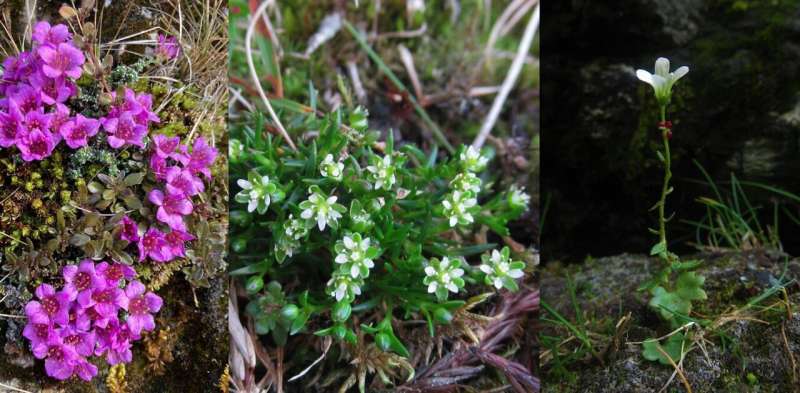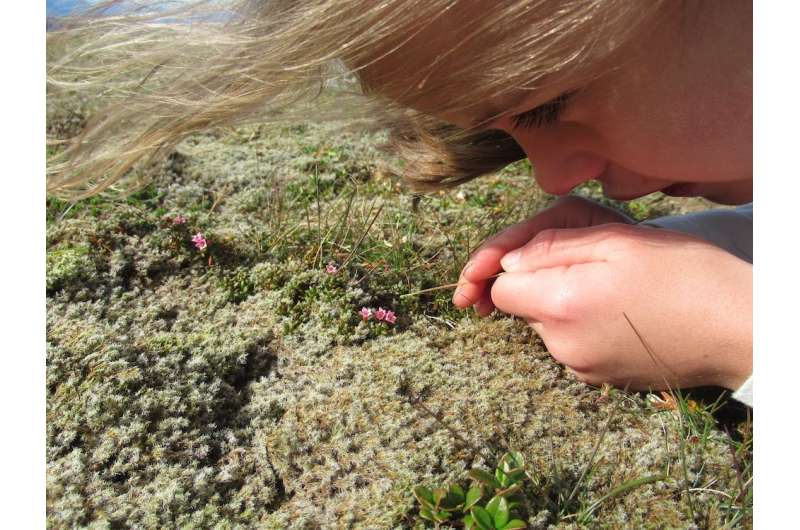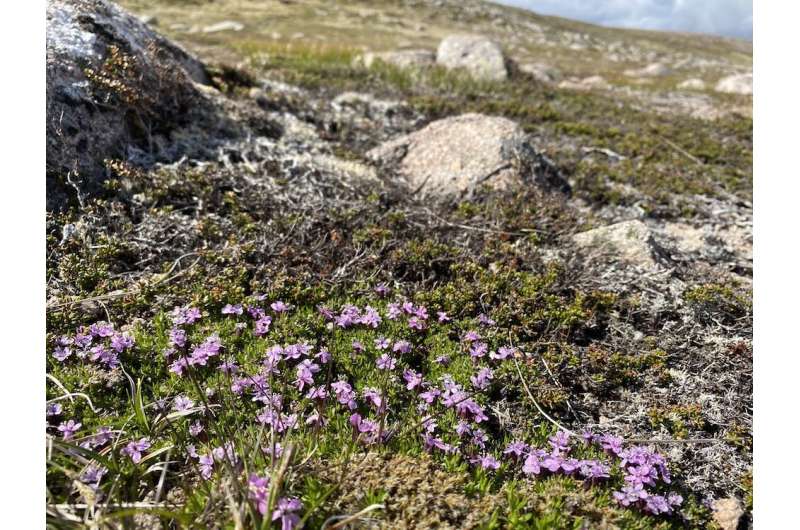Tiny but tenacious: Arctic-alpine plants are engineers and warning bells

When most people consider the arctic, or high-altitude mountain landscapes, they think of endless snow, ice and bare rock. But pastel-colored flowers, sometimes just a few millimeters wide, bloom in these dramatic places too. The miniature flowers not only weather some of the toughest habitats on Earth, but can also help engineer the landscape for other species.
Don't be fooled by their delicate petals. Some species of rock jasmine and sandwort grow at on Mount Everest, while flourishes on the northernmost point of land in the world—Kaffeklubben Island, north of Greenland—and throughout the Arctic, Alaska and the tips of the European Alps.
Plants in freezing cold environments are typically small and often form as ground-hugging rosettes, or dense tufts with short stems, known as cushions. Antarctic pearlwort and displays a tight bunch of minute yellow blooms. The , where temperatures can drop to -27℃ in winter, are home to also found in the Arctic, such as moss campion, dwarf willow, trailing azalea and starry saxifrage.
Although plants such as these may appear fragile, their minute size helps them cope with freezing weather and fierce winds. Low stature and tightly packed leaves act as an aerodynamic trap and storage system for water and solar radiation. Microspaces within the dense, dome-like foliage are efficient structures for retaining moisture and heat. An arctic-alpine cushion's internal temperature .
Pioneer plants

Cushion plants and mosses can be integral to their local environment (known as ) and because they stabilize their harsh microclimate, and are often the first to colonize bare ground. As the cushions grow, they of thin soils by both directly within the plant itself, and through their root systems. By , cushions reduce the frost risk in their immediate surroundings. These processes create a habitat more suitable for less stress-tolerant plant species including arctic-alpines in the and families.
Cushion formers are therefore vital in mountain and polar regions. They also shelter including and tiny wingless insects called .
These animals may in turn , and provide food for others higher up the food chain.
An alarming trend
However, these tiny arctic-alpine plants are now sounding a warning bell for the loss of biodiversity (the richness and variety of living things on earth) due to climate change. The plants have an , which offers them protection from disturbance and erosion. But rising temperatures are causing earlier snow melt, allowing the spread of other species previously restricted to lower altitudes and latitudes. Consequently, , such as common grasses and are crowding out the smaller arctic-alpines.

High mountain areas are and are from other places with similar climates, leaving the specialist flowers nowhere to relocate to.
Arctic-alpine plant numbers are plummeting and climate change is impacting numbers , threatening the future of species that depend on them. , a cushion plant usually no bigger than a penny, is the to have its status moved from vulnerable to endangered due to climate change. Our research using has shown that snow pearlwort, mountain sandwort and drooping saxifrage are withdrawing uphill and face mountaintop extinction because there is no higher ground left for them to retreat to as temperatures rise.
If we lose these plants from their British mountaintop outposts—at the edge of where they occur globally—this will signal that their strongholds in the Arctic and the Alps are also in danger.
Polar and mountain regions are havens for biodiversity, nurturing . We risk losing that rare species give us, with implications for the preservation of our natural heritage.
Plants are the building blocks of habitats and food webs on which other lifeforms across the planet depend, but they are frequently overlooked in conservation news stories. There's a name for this phenomenon—. Scientists, nature writers and the media usually turn to or species with to open people's eyes to the importance of plant life.
But we must celebrate and protect our tiniest of plants. If we don't the spectrum of diversity across earth's extremes will be lost for generations to come.
Provided by The Conversation
This article is republished from under a Creative Commons license. Read the .![]()




















